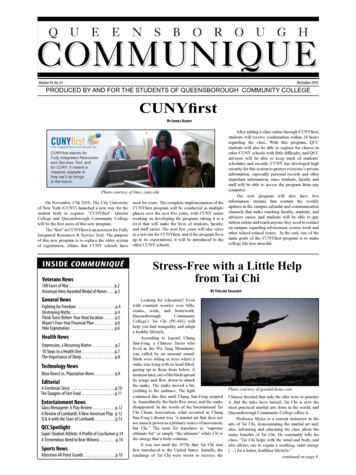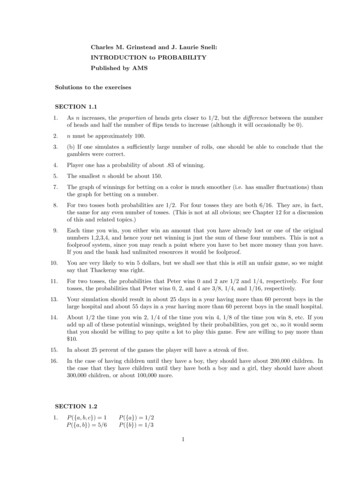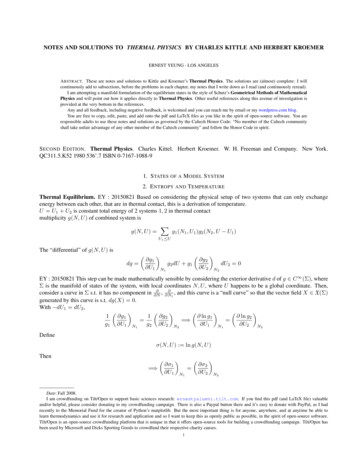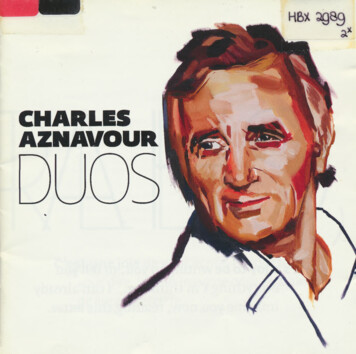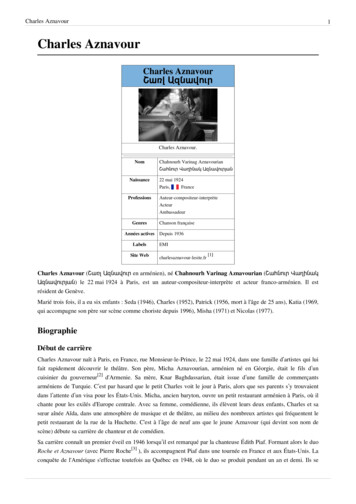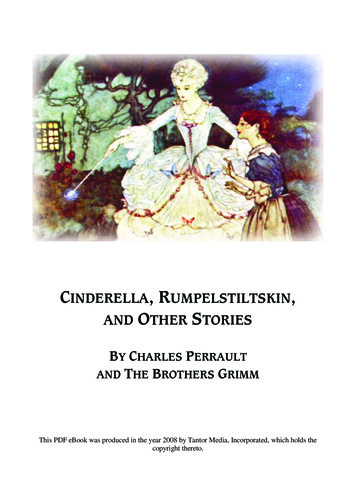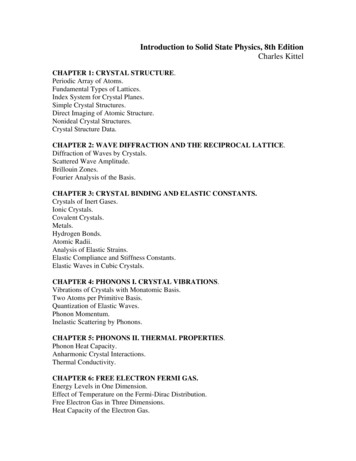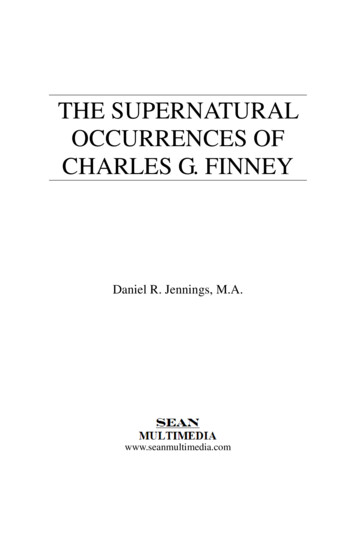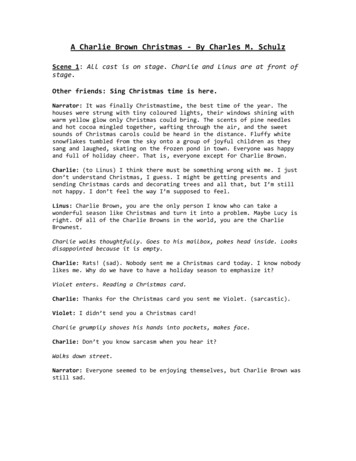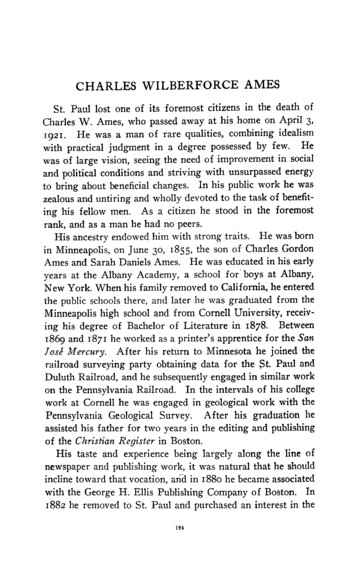
Transcription
CHARLES WILBERFORCE AMESSt. Paul lost one of its foremost citizens in the death ofCharles W. Ames, who passed away at his home on April 3,1921. He was a man of rare qualities, combining idealismwith practical judgment in a degree possessed by few. Hewas of large vision, seeing the need of improvement in socialand political conditions and striving with unsurpassed energyto bring about beneficial changes. In his public work he waszealous and untiring and wholly devoted to the task of benefiting his fellow men. As a citizen he stood in the foremostrank, and as a man he had no peers.His ancestry endowed him with strong traits. He was bornin Minneapolis, on June 30, 1855, the son of Charles GordonAmes and Sarah Daniels Ames. He was educated in his earlyyears at the Albany Academy, a school for boys at Albany,New York. When his family removed to California, he enteredthe public schools there, and later he was graduated from theMinneapolis high school and from Cornell University, receiving his degree of Bachelor of Literature in 1878. Between1869 and 1871 he worked as a printer's apprentice for the SanJose" Mercury. After his return to Minnesota he joined therailroad surveying party obtaining data for the St. Paul andDuluth Railroad, and he subsequently engaged in similar workon the Pennsylvania Railroad. In the intervals of his collegework at Cornell he was engaged in geological work with thePennsylvania Geological Survey. After his graduation heassisted his father for two years in the editing and publishingof the Christian Register in Boston.His taste and experience being largely along the line ofnewspaper and publishing work, it was natural that he shouldincline toward that vocation, and in 1880 he became associatedwith the George H. Ellis Publishing Company of Boston. In1882 he removed to St. Paul and purchased an interest in the
J92iCHARLESW. AMES125West Publishing Company. He served at first as secretary,then as general manager, and for a long period of years aspresident of the company. As a business man, Mr. Ames wasof rare capacity. He united a keen sense of fair dealing withunusual energy and good judgment. Under his excellent business guidance the company became very prosperous, and formany years it has been the largest law publishing plant in theworld. No small share of its success is due to his energy andforesight. He was also a director of the Northwestern TrustCompany and of the First National Bank of St. Paul, and ofthe American Law Book Company of New York; and he wasactively interested in many lesser companies to which he gavemuch time and attention.But while interested in business, Mr. Ames did not allow itto absorb his whole attention. Early in his life in St. Paul hebegan to take a large part in public affairs. No worthy enterprise was too onerous to engage his active mental and physicalcooperation, and it was his fortune to see many small institutions and ventures of a public nature blossom into large andhealthy maturity. Education was with him a never-failingsource of enthusiasm. He organized the Loomis School forgirls; he was active in the inauguration of the St. Paul Academy for boys; and, later, he was the prime mover in the establishment of this academy's country day school at Randolph andSnelling avenues. In the work of the public library he was particularly interested. During his long membership on the boardof directors he brought about many wise innovations and developed the usefulness of the library by promoting the establishment of branches in a dozen parts of the city, which enabled theinstitution to serve a much larger constituency. When the agitation for the new library building was started, he took up thework with energy, and he was largely responsible for thesplendid building which now is one of the architectural features of the city.In the religious field Mr. Ames's activities were very productive. His father was a Unitarian clergyman, and the son,
126ARTHURSWEENEYAUG.-NOV.in no less degree, applied his energy and zeal to the work ofthis creed. During the pastorate of the Reverend SamuelCrothers at the old Unity Church on Wabasha Street, Mr.Ames took an active part in church work, developing theSunday school and occasionally occupying the pulpit in theabsence of the pastor. The influence of his deep religious feeling was always shown in his keen interest in and healthy sympathy for others. No man had a larger or more healthfulinfluence upon his friends and acquaintances, largely becauseof his broad charity and his keen sense of responsibility for hisspiritual as well as his physical welfare. His religious naturewas not obtrusive but showed itself rather in a kindly andfriendly interest in his fellow men.Mr. Ames was largely responsible for the founding, in1908, of the St. Paul Institute, to which he devoted much ofhis time and money and which he brought to a successful andflourishing condition. He was impressed by the fact that,after the termination of the instruction received in the gradeschools, the man of mature years had no opportunity to pursuehis studies further. The idea that night schools should beestablished led to the conception of the institute, the scope ofwhich later was broadened to meet the requirements, in art,natural history, and other cultural matters, of all classes ofpeople. The work of Mr. Ames in inaugurating and renderingpossible the completion of this great public institution is amongthe most valuable of his accomplishments as a citizen. Throughthis conception the desire of the public for education, not onlyin practical but also in cultural fields, is gratified. The institute has made St. Paul a better place to live in, for it hasimproved the opportunity for good citizenship and for theenjoyment of the cultural things which really are essential tonormal life and development. Mr. Ames was much interestedin art. He fostered exhibitions of the paintings of local andwestern artists, and he contributed not a few paintings to theinstitute gallery. His contributions to the institute's naturalhistory museum were frequent and valuable. Through his
i92iCHARLESW. AMES127efforts the institute has become one of the city's greatest educational and cultural factors.Another of his interesting achievements is the InformalClub, of which he was secretary for twenty-seven years. Witha few others he organized this club, composed of sixty of theleading business and professional men of the city, for thepurpose of discussing topics of general interest. The club washeld together by the slenderest official ties, and it was almostwholly the genial personality of Mr. Ames, together with hisbright wit and original point of view, which infused vitalityand interest into the group. Those who were fortunate enoughto be members have the most pleasant recollections of thetemperate and scholarly atmosphere he lent to all discussionsand the keen logic with which he analyzed the debates.In philanthropy Mr. Ames assumed more than his full dutyas a citizen. Aside from his large contributions to the St. PaulInstitute, he was ever ready with his purse when charitycalled. He was in close touch with all the philanthropic organizations of St. Paul, and for several years he was a directorof the Amherst H. Wilder Charity. His last public service ofthis nature was in connection with the organization of theCommunity Chest, of which he was an ardent promoter andsupporter.He was interested in all activities which concern the averagecitizen, and he constantly endeavored to improve the facilitiesfor business and social intercourse. It was largely due to hisefforts that the former Chamber of Commerce and the Commercial Club were merged into the St. Paul Association ofPublic and Business Affairs, and that the St. Paul AthleticClub was united with the latter in the present commodiousquarters. It was no easy task to bring together the three ratherdiscordant elements of these organizations in one enterprise,housed in a single building, and united in the general effortto improve the social and business relations of our merchants.Perhaps in no part of his life did the splendid nature ofMr. Ames manifest itself more fully than in his patriotic serv-
128ARTHURSWEENEYAUG.-NOV.ice during the World War. Early in the war he perfected anorganization for the French war sufferers; he made a visitto France in 1916 to confer with those who were administeringrelief to the suffering; and he contributed an ambulance tothe cause. He converted his home into a workshop in whichhis family and friends labored unceasingly in providing bandages, clothing, and other necessities to bring relief to the destitute of the warring countries. His contribution of materialas well as of money to this work was very large. He laterorganized a local committee of the Fatherless Children ofFrance, which provided for the care of hundreds of orphans.Not the least of his war services was rendered as a member ofthe Minnesota Commission of Public Safety. His energy andzeal contributed a great deal to the efficient work of that body.In recognition of the large share he took in relieving theFrench war sufferers, he was awarded by the French government the title of Chevalier de la Legion d'Honneur, whichwas conferred upon him at a large public gathering by M.Marcel Knecht in 1919.Mr. Ames was married in 1883 to Miss Mary Lesley, daughter of Professor J. P. Lesley of Philadelphia. H e is survivedby his widow, his sons, Charles Lesley and Theodore, andfour daughters, Mrs. Cushing Wright, Mrs. S. Eppes Turner,and Miss Elizabeth Ames of St. Paul, and Mrs. BronsonCrothers of Boston.The very plethora of his activities and the variety of formsin which his genius showed itself make it difficult to give anestimate of the character and achievements of Charles W.Ames. There was scarcely any human activity during his lifein which he did not take a part. He was unstinted in usinghis energy in behalf of every worthy cause, and he threw himself, without scrutinizing the cost, into every movement forthe betterment of his fellow men. He was a man of tremendousforce, and always worked his physical and mental powers atthe highest pitch. Added to the zeal of his convictions was
i92iCHARLESW. AMES129the devotion of the man who submerged self that the greatideals he cherished might be attained. He was a practicalidealist, holding high standards of human welfare, but neverlosing sight of the realities. He was a dreamer of largedreams, and fortunately most of his dreams came true. Thewellspring of his activities was mainly his love for his fellowmen. His life is one long story of things accomplished thattended to make life more agreeable, to make work more fruitful, and to create always a higher type of citizenship. Hisbelief in the need of cultural things to smooth off the sharp andugly corners of the daily life of the people led him to the interests in music, art, and education which have blossomed intofruition.His personal character was very lovable. He was genialand kindly, always taking an optimistic view of life and seekingout and finding the best in his fellow men. He possessed amost sympathetic nature, a clear and logical mind, and a witthat was unexcelled. His extensive knowledge of current eventsenabled him to see with clear vision things that to othersseemed confused and involved. He was a charming conversationalist and public speaker, a widely-read man in all good literature, a lover of art and music, and a devotee of the culturalthings of life. He was a man of large influence, and his fellowcitizens had unbounded faith in his wisdom and good intentions.No higher praise can be given to a man than to say that inhim was personified a good citizen. This means that, devoidof self interest, he constantly promoted the welfare of hisneighbor and the community in which he lived. Lookingback on his many accomplishments for the good of the city ofSt. Paul, we may say with truth that no man strove moregreatly, accomplished more good, nor left a higher exampleof citizenship than Charles W. Ames.ARTHUR SWEENEYST. PAUL, MINNESOTA
Copyright of Minnesota History is the property of the MinnesotaHistorical Society and its content may not be copied or emailed tomultiple sites or posted to a listserv without the copyright holder’sexpress written permission. Users may print, download, or emailarticles, however, for individual use.To request permission for educational or commercial use, contact us.www.mnhs.org/mnhistory
Ames and Sarah Daniels Ames. He was educated in his early years at the Albany Academy, a school for boys at Albany, New York. When his family removed to California, he entered the public schools there, and later he was graduated from the Minneapolis high school and from Cornell University,
